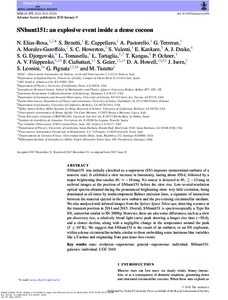SNhunt151: an explosive event inside a dense cocoon
Djorgovski SG; Elias-Rosa N; Pignata G; Terreran G; Ciabattari F; Howell DA; Drake AJ; Geier S; Kangas T; Leonini S; Ochner P; Filippenko AV; Howerton SC; Valenti S; Isern J; Cappellaro E; Morales-Garoffolo A; Kankare E; Tomasella L; Turatto M; Benetti S; Tartaglia L; Pastorello A
SNhunt151: an explosive event inside a dense cocoon
Djorgovski SG
Elias-Rosa N
Pignata G
Terreran G
Ciabattari F
Howell DA
Drake AJ
Geier S
Kangas T
Leonini S
Ochner P
Filippenko AV
Howerton SC
Valenti S
Isern J
Cappellaro E
Morales-Garoffolo A
Kankare E
Tomasella L
Turatto M
Benetti S
Tartaglia L
Pastorello A
OXFORD UNIV PRESS
Julkaisun pysyvä osoite on:
https://urn.fi/URN:NBN:fi-fe2021042718987
https://urn.fi/URN:NBN:fi-fe2021042718987
Tiivistelmä
SNhunt151 was initially classified as a supernova (SN) impostor (nonterminal outburst of a massive star). It exhibited a slow increase in luminosity, lasting about 450 d, followed by a major brightening that reaches M-V approximate to -18 mag. No source is detected to M-V greater than or similar to -13 mag in archival images at the position of SNhunt151 before the slow rise. Low-to-mid-resolution optical spectra obtained during the pronounced brightening show very little evolution, being dominated at all times by multicomponent Balmer emission lines, a signature of interaction between the material ejected in the new outburst and the pre-existing circumstellar medium. We also analysed mid-infrared images from the Spitzer Space Telescope, detecting a source at the transient position in 2014 and 2015. Overall, SNhunt151 is spectroscopically a Type IIn SN, somewhat similar to SN 2009ip. However, there are also some differences, such as a slow pre-discovery rise, a relatively broad light-curve peak showing a longer rise time (similar to 50 d), and a slower decline, along with a negligible change in the temperature around the peak (T <= 10(4) K). We suggest that SNhunt151 is the result of an outburst, or an SN explosion, within a dense circumstellar nebula, similar to those embedding some luminous blue variables like eta Carinae and originating from past mass-loss events.
Kokoelmat
- Rinnakkaistallenteet [19207]
